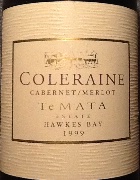
External search
Google (images)
Wine Advocate
Wine Spectator
Burghound
Wine-Searcher
Vintages
2022
2021
2020
2019
2018
2017
2016
2015
2014
2013
2012
2011
2010
2009
2008
2007
2006
2005
2004
2003
Show more
From this producer
Show all wines
All tasting notes
|
| Drinking Windows and Values |
| Drinking window: Drink between 2007 and 2018 (based on 347 user opinions) |
| Community Tasting History |
| Community Tasting Notes (average 89.5 pts. and median of 89 pts. in 5 notes) - hiding notes with no text | | | Tasted by BTBNZ on 12/24/2023: Drinking at peak. Opened up in the glass- beautiful balance. Nose of cedar and dry fruit. (109 views) | | | Tasted by Ribes Holdings on 4/4/2022 & rated 88 points: Drank in 2022, probably past its best. Just going bricky red, but still flavoursome. (203 views) | | | Tasted by skklam@hotmail.com on 9/2/2011 & rated 91 points: Very attractive and lovely smell, long finish, quite structural. (2463 views) | | | Tasted by Rupert on 5/19/2008 & rated 89 points: Te Mata Coleraine vertical (Institute of Directors, London): Intense and focused, a sharp fragrance, quite sharp (like all these wines), less distinctive on the palate, and less structured than the 1998 (3574 views) |
| Te Mata Estate Producer website
Established in 1896, Te Mata Estate is a family owned winery, making wine from hand-harvested vineyards controlled by the winery. Te Mata estate sits on the site of New Zealand's oldest winery, and is considered to produce New Zealand's best, or at least most consistent, Bordeaux blend in the form of Coleraine. Red Bordeaux BlendRed Bordeaux is generally made from a blend of grapes. Permitted grapes are Cabernet Sauvignon, Cabernet Franc, Merlot, Petit Verdot, Malbec and rarely Carménère.Today Carménère is rarely used, with Château Clerc Milon, a fifth growth Bordeaux, being one of the few to still retain Carménère vines. As of July 2019, Bordeaux wineries authorized the use of four new red grapes to combat temperature increases in Bordeaux. These newly approved grapes are Marselan, Touriga Nacional, Castets, and Arinarnoa.
Wineries all over the world aspire to making wines in a Bordeaux style. In 1988, a group of American vintners formed The Meritage Association to identify wines made in this way. Although most Meritage wines come from California, there are members of the Meritage Association in 18 states and five other countries, including Argentina, Australia, Canada, Israel, and Mexico.New Zealand New Zealand Wine (New Zealand Winegrowers)North IslandHaving a cool factor is a great start.
When they were creating climate classifications for wine regions around the world, we weren’t exactly complaining that New Zealand’s was called ‘cool.’ Step out in the middle of the day on a classic Marlborough or Hawke’s Bay’s summer, and you may wonder if they got it right. The brightness is beautifully intense, and sunshine plentiful.
But stay about a little. Until nightfall. The shift from day to night isn’t just defined by light, but temperature too. It chills quickly. The South Pacific Ocean taking its deep breath over our two islands. For the grapes, this makes for more than a chilly night. Ripening is gradual, almost methodical. As each day edges the grape towards ripeness, each night captures its flavour.
This pattern creates one of the longest grape growing seasons on earth – and those unmistakable, remarkable zesty flavours, and fragrance that are the hallmark of our wines.

Sometimes the world really is your oyster.
Hawke's BayThe philosophy of Oyster Bay is to produce fine, distinctively regional wines that are elegant and assertive with glorious fruit flavours.
The Hawke’s Bay wine region is arguably the most exciting find in recent times for the cultivation of Merlot in New Zealand. Ancient alluvial river terraces provide for a superb mix of soils over gravelly, free draining subsoils, with an abundance of pure river water or irrigation.
With a temperate maritime climate, the vines are warmed by strong clear sunlight during the day and cooled at night by the sea breezes of the Pacific Ocean.
This is the unique environment in which Merlot produces its vibrant, fully-ripened varietal flavours.
Essentially, Oyster Bay Hawke’s Bay Merlot is about elegance and intensity of fruit. The hero is always freshness of ripe fruit, spice and soft tannins on the palate. |
|




